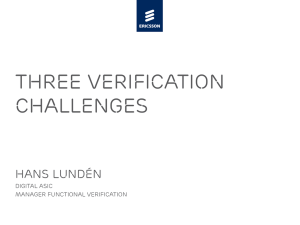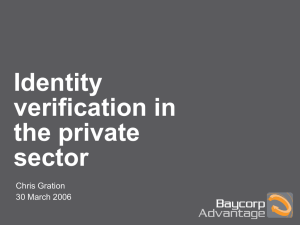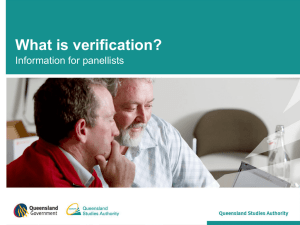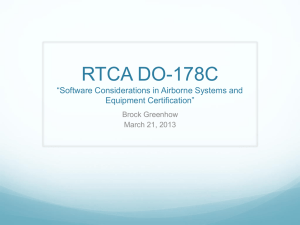Integration Verification
advertisement
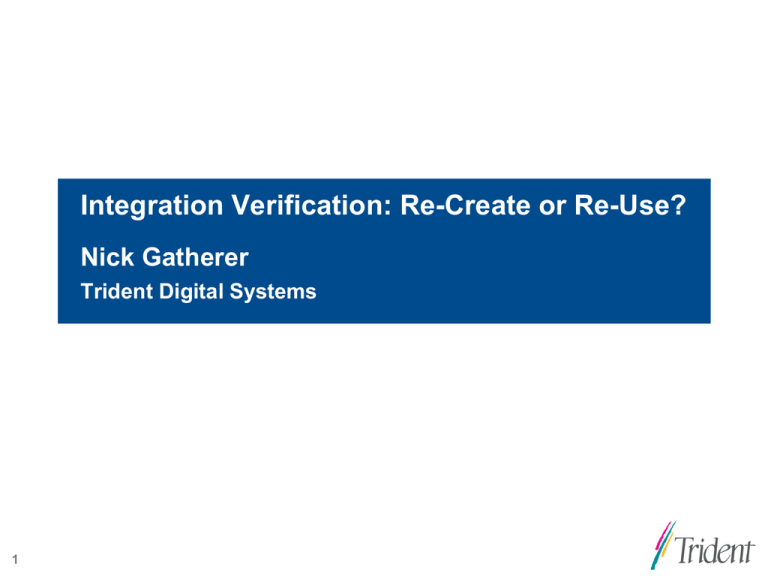
Integration Verification: Re-Create or Re-Use? Nick Gatherer Trident Digital Systems 1 Introduction Nick Gatherer SoC Design Manager Trident Digital Systems (Formerly BU TV, NXP Semiconductors) In former NXP role … • Chair of NXP’s Advanced Functional Verification Working Group - NXP’s cross-business expert team on verification • NXP Business Renewal project manager for System Level Design & Verification 2 Agenda Introduction & Verification Landscape Focus on Integration Verification Challenges What does it cost ? The IP Integrator Interface Example verification re-use methodology Conclusions Q&A 3 Trident – SoCs for DTV & STB (high complexity !) • PNX85500 • Industry’s first digital TV processor in 45nm CMOS • Most complex SoC ever developed by NXP/Trident • Required aggressive TtM & Right First Time • From packaged parts received to System bring up in less than 10 days • Very high level of functionality and performance • PNX847x/8x/9x 4 • World’s first fully integrated 45nm Set Top Box SoC platform • Architectural & IP re-use from PNX85500 (internal & 3rd party IP) Functional Verification – A Holistic Approach System validation HW/SW integration & co-verification SW development HW Integration Hardware IP Virtual Prototype RTL Simulation FPGA Prototype Emulation Verification Technology Landscape • Select appropriate platform per project phase • Availability vs Accuracy vs Performance vs Debuggability • Allocate coverage goals to specific platforms 5 Silicon Functional Verification – Re-Use Opportunities System validation Re-use across verification tasks/abstractions HW/SW integration & co-verification Re-use across projects SW development HW Integration Re-use across verification platforms Hardware IP Virtual Prototype RTL Simulation FPGA Prototype Emulation Silicon Verification Technology Landscape • Verification re-use depends on stakeholder alignment • IP suppliers, IP integrators, verification teams, technology/standards 6 Agenda Introduction & Verification Landscape Focus on Integration Verification Challenges What does it cost ? The IP Integrator Interface Example verification re-use methodology Conclusions Q&A 7 Integration Verification – Challenges • HW integration verification • Focus on (structural) integration integrity • Interconnect & interoperability • Typical Challenges • Integrator has limited knowledge of IP implementation • IP supplier has limited knowledge of target system • Use of multiple IP suppliers results in inconsistent IP verification views • Methodology, testbenches, coverage data, etc. Industry standards late. • Mechanisms for accommodating IP configuration • Usually need to port IP tests to SoC level / environment in order to re-use • Huge effort ! What sub-set is needed for integration verification ? • Awareness and impact of IP implementation changes & known problems • Concurrent IP dev and SoC integration demands incremental maturity • Difficult to debug complex interactions between IPs (embedded checks help) 8 • How much coverage is sufficient for integration confidence ? Agenda Introduction & Verification Landscape Focus on Integration Verification Challenges What does it cost ? The IP Integrator Interface Example verification re-use methodology Conclusions Q&A 9 Integration Verification – What does it cost per IP ? • Example project (from subsequent data mining) … Integration Test IP with no external I/O, IP with external I/O, no DMA, no master IF DMA, but no master IF [weeks] [weeks] IP with external I/O, DMA and bus master IF [weeks] Register Access Clock & Reset Connectivity Interrupt Connectivity Stub Integration I/O Connectivity DMA Connectivity Communication Stub/CPU Bus Master Interface Total 0.5 – 1.0 0.5 – 1.0 0.5 – 1.0 0.5 – 1.0 0.5 – 1.0 0.5 – 1.0 0.5 – 1.5 n.a. n.a. n.a. n.a. 0.5 – 1.5 1.0 – 4.0 0.5 – 1.5 1.0 – 2.0 n.a. 0.5 – 1.5 1.0 – 4.0 0.5 – 1.5 1.0 – 2.0 1.0 – 4.0 n.a. 1.5 – 3.5 n.a. 4.0 – 11.0 1.0 – 3.0 6.0 – 18.0 Effort for integration verification is 50%-75% of the total SoC front end work Re-use is a must!!! 10 Integration Verification – What does it cost per SoC ? For a medium complexity SoC with around 50 IPs … Integration verification effort is 100 – 250 man weeks − Effort can vary a lot depending on how much integration verification can be re-used from previous projects − Effort can vary a lot depending on what is delivered by the IP provider (verification components) Example project plan (based on 50% IP verification re-use) Total effort reduced by 103 man weeks (approx 2 man years !) Significant improvement potential on the IP provider side Design for integration verification Significant improvement potential on the SoC integrator side Align on a common methodology 11 Agenda Introduction & Verification Landscape Focus on Integration Verification Challenges What does it cost ? The IP Integrator Interface Example verification re-use methodology Conclusions Q&A 12 IP Integrator Interface for verification HW Integration (views delivered by IP suppliers that support integration) IP Datasheet (functionality, interfaces, etc) & Maturity index Verification report … IP verification strategy/plan & results (RTL, N/L, FPGA) Code & functional coverage Checklist/maturity, limitations, waivers, and open issues Simulation vectors Full & reduced set for integration Emulation models as needed to support mapping Simulation models as needed to support testbench XML register description to support test creation BFMs, eVC’s, OVC’s Interface & protocol assertion checkers IP specification & integration reviews (ideally face-2-face) Joint silicon bring-up & validation RTL Simulation 13 Emulation Agenda Introduction & Verification Landscape Focus on Integration Verification Challenges What does it cost ? The IP Integrator Interface Example verification re-use methodology Conclusions Q&A 14 Verification SW – Methodology Overview • Objective: • Enable IP suppliers to deliver IP integration tests SoC CPU INTC DMAC MEMC mem • Implementation • Software-centric verification approach IP • ‘C’ tests run on any embedded processor (or transactor) • Non-invasive and runs on all implementation levels 1 IP2 IPn IPx • SystemC, RTL, netlist, FPGA, emulation, silicon • API defined to ensure standard methodology • Allows IP supplier to define: • In-context connectivity verification test • Register tests can be generated automatically from IP-XACT metadata • Inter-operability test with generic platform functions • interrupt, DMA, clock, reset, power • IP context information is applied at the SoC integration phase • Allows automatic test program generation from suitable integration environment 15 Verification SW – Re-Use Example IO-Stub IO-Stub IOs SoC IOs CPU Verification SW IP Supplier IP DMA INTC Bus Interface IP Bus Interface Logic CGU CPU Verification SW SoC Integrator (Chip context applied) IP supplier delivers STANDARDIZED verification components Plug and Play Integration Verification 16 Agenda Introduction & Verification Landscape Focus on Integration Verification Challenges What does it cost ? The IP Integrator Interface Example verification re-use methodology Conclusions Q&A 17 Conclusions • Verification continues to consume significant time & effort for complex SoCs • Design re-use is now well established • Verification re-use needs to catch up ! • IP is usually delivered with support for integration verification, but lacks consistency between suppliers • There’s a big difference between ‘re-usable’ and ‘almost re-usable’ ! • Proprietary approaches have emerged to overcome lack of industry standards, but these are not robust against industry dynamics • Overall …. • Design IP is a MUST • IP support for integration verification is a MUST • Need more standardisation of approach 18 Agenda Introduction & Verification Landscape Focus on Integration Verification Challenges What does it cost ? The IP Integrator Interface Example verification re-use methodology Conclusions Q&A 19
